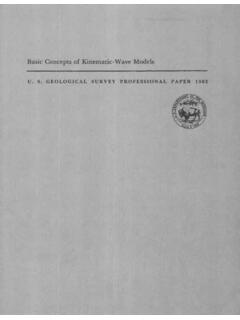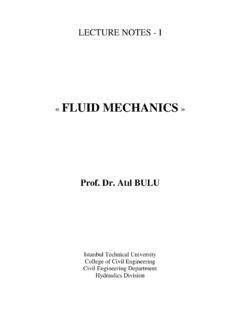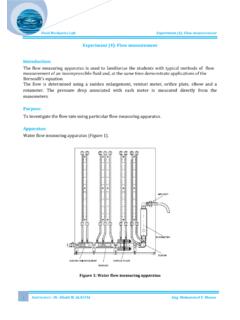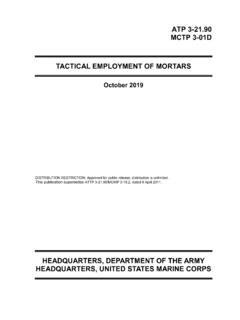Transcription of Introduction to Fracture Mechanics
1 Introduction to Fracture MechanicsDavid RoylanceDepartment of Materials Science and EngineeringMassachusetts institute of TechnologyCambridge, MA 02139 June 14, 2001 IntroductionIn 1983, the National Bureau of Standards (now the National institute for Science and Tech-nology) and Battelle Memorial Institute1estimated the costs for failure due to Fracture to be$119 billion per year in 1982 dollars. The dollars are important, but the cost of many failuresin human life and injury is infinitely more have occurred for many reasons, including uncertainties in the loading or envi-ronment, defects in the materials, inadequacies in design, and deficiencies in construction ormaintenance.
2 Design against Fracture has a technology of its own, and this is a very activearea of current research. This module will provide an Introduction to an important aspect ofthis field, since without an understanding of Fracture the methods in stress analysis discussedpreviously would be of little use. We will focus on fractures due to simple tensile overstress,but the designer is cautioned again about the need to consider absolutely as many factors aspossible that might lead to failure, especially when life is at Module on the Dislocation Basis of Yield (Module 21) shows how the strength of struc-tural metals particularly steel can be increased to very high levels by manipulating themicrostructure so as to inhibit dislocation motion.
3 Unfortunately, this renders the material in-creasingly brittle, so that cracks can for mand propagate catastrophically with very little warn-ing. An unfortunate number of engineering disasters are related directly to this phenomenon,and engineers involved in structural design must be aware of the procedures now available tosafeguard against brittle central difficulty in designing against Fracture in high-strength materials is that thepresence of cracks can modify the local stresses to such an extent that the elastic stress analysesdone so carefully by the designers are insufficient. When a crack reaches a certain criticallength, it can propagate catastrophically through the structure,even though the gross stress ismuch less than would normally cause yield or failure in a tensile specimen.
4 The ter m fracturemechanics refers to a vital specialization within solid Mechanics in which the presence of a crackis assumed, and we wish to find quantitative relations between the crack length, the material sinherent resistance to crack growth, and the stress at which the crack propagates at high speedto cause structural Reed et al., NBS Special Publication 647-1, Washington, Griffith (1893 1963) began his pioneering studies of Fracture in glass in the yearsjust prior to 1920, he was aware of Inglis work in calculating the stress concentrations aroundelliptical holes2, and naturally considered how it might be used in developing a fundamentalapproach to predicting Fracture strengths.
5 However, the Inglis solution poses a mathematicaldifficulty: in the limit of a perfectly sharp crack, the stresses approach infinity at the cracktip. This is obviously nonphysical (actually the material generally undergoes some local yieldingto blunt the cracktip), and using such a result would predict that materials would have near-zerostrength: even for very small applied loads, the stresses near crack tips would becomeinfinite, and the bonds there would rupture. Rather than focusing on the crack-tip stressesdirectly, Griffith employed an energy-balance approach that has become one of the most famousdevelopments in materials strain energy per unit volume of stressed material isU =1V fdx= fAdxL= d If the material is linear ( =E ), then the strain energy per unit volume isU =E 22= 22 EWhenacrackhasgrownintoasolidtoadeptha,a region of material adjacent to the freesurfaces is unloaded, and its strain energy released.
6 Using the Inglis solution, Griffith was ableto compute just how much energy this 1: Idealization of unloaded region near crack , illustrated , istoregardtwo triangularregions near the crack flanks, of widthaand height a, as being completely unloaded, while theremaining material continues to feel the full stress . The parameter can be selected so as to2 See Module Griffith,Philosophical Transactions,Series A, Vol. 221, pp. 163 198, 1920. The importance of Griffith swork in Fracture was largely unrecognized until the 1950 s. See Gordon,The Science of Structures andMaterials,Scientific American Library, 1988, for a personal account of the Griffith with the Inglis solution, and it turns out that for plane stress loading =.
7 The totalstrain energyUreleased is then the strain energy per unit volume times the volume in bothtriangular regions:U= 22E a2 Here the dimension normal to thex-yplane is taken to be unity, soUis the strain energyreleased per unit thickness of specimen. This strain energy isliberatedby crack growth. But informing the crack, bonds must be broken, and the requisite bond energy is in effectabsorbedbythe material. The surface energySassociated with a crack of lengtha(and unit depth) is:S=2 awhere is the surface energy ( , Joules/meter2) and the factor 2 is needed since two freesurfaces have been formed. As shown in Fig.
8 2, the total energy associated with the crack isthen the su mof the (positive) energy absorbed to create the new surfaces, plus the (negative)strain energy liberated by allowing the regions near the crack flanks to become 2: The Fracture energy the crack grows longer (aincreases), the quadratic dependence of strain energy onaeventually dominates the surface energy, and beyond a critical crack lengthacthe syste mcanlower its energy by letting the crack grow still longer. Up to the point wherea=ac,thecrackwill grow only if the stress in increased. Beyond that point, crack growth is spontaneous value of the critical crack length can be found by setting the derivative of the totalenergyS+Uto zero: (S+U) a=2 2fE a=0 Sincefastfractureis imminentwhenthis condition is satisfied, wewritethestress as , f= 2E aGriffith s original work dealt with very brittle materials, specifically glass rods.
9 When thematerial exhibits more ductility, consideration of the surface energy alone fails to provide an3accurate model for Fracture . This deficiency was later remedied, at least in part, independentlyby Irwin4and Orowan5. They suggested that in a ductile material a good deal in fact thevast majority of the released strain energy was absorbed not by creating new surfaces, butby energy dissipation due to plastic flow in the material near the crack tip. They suggestedthat catastrophic Fracture occurs when the strain energy is released at a rate sufficient to satisfythe needs of all these energy sinks, and denoted thiscritical strain energy release rateby theparameterGc; the Griffith equation can then be rewritten in the form: f= EGc a(1)This expression describes, in a very succinct way, the interrelation between three importantaspects of the Fracture process: thematerial, as evidenced in the critical strain energy releaserateGc;thestress level f;andthesize,a, of the flaw.
10 In a design situation, one might choose avalue ofabased on the smallest crack that could be easily detected. Then for a given materialwith its associated value ofGc,thesafelevelofstress fcould be determined. The structurewould then be sized so as to keep the working stress comfortably below this critical 1 The story of the DeHavilland Comet aircraft of the early 1950 s, in which at least two aircraftdisintegrated in flight, provides a tragic but fascinating insight into the importance of Fracture theory. Itis an eerie story as well, having been all but predicted in a 1948 novel by Nevil Shute namedNo book later became a movie starring James Stewart as a perserverant metallurgist convinced that hiscompany s new aircraft (the Reindeer ) was fatally prone to metal fatigue.

















